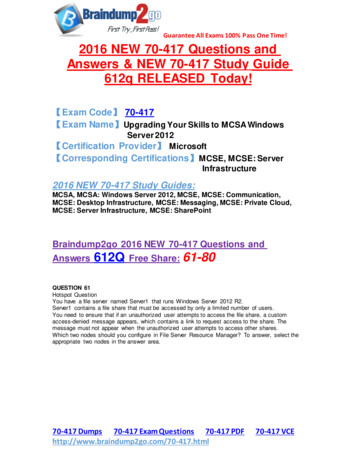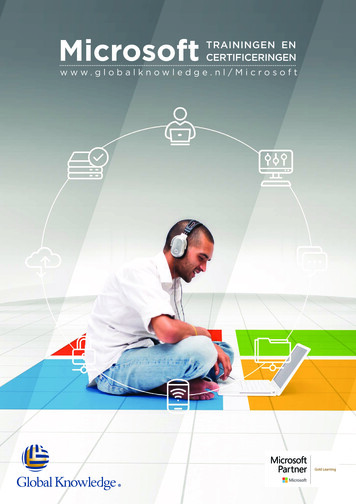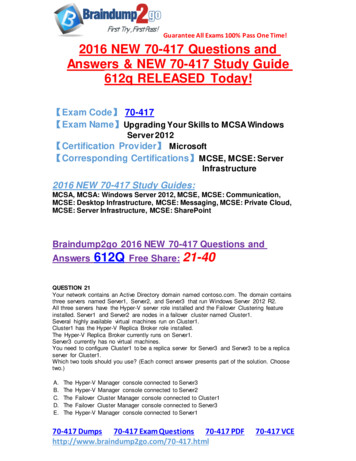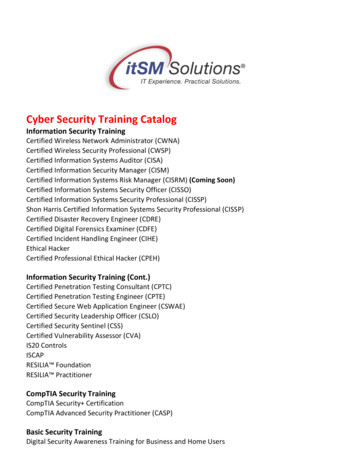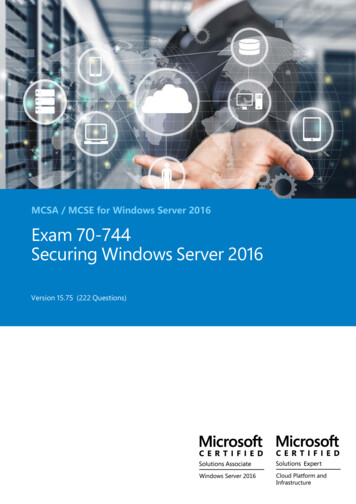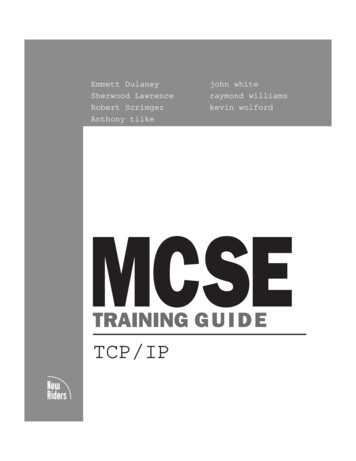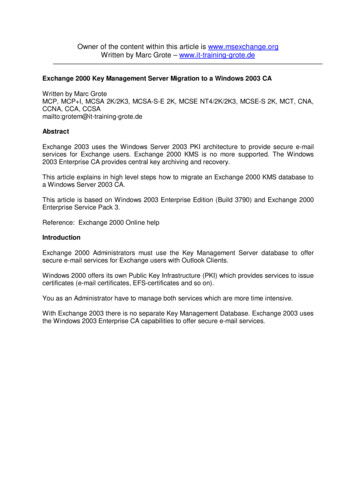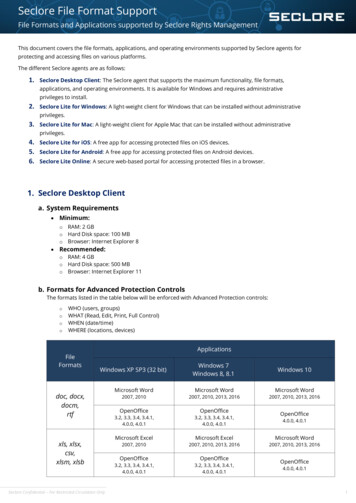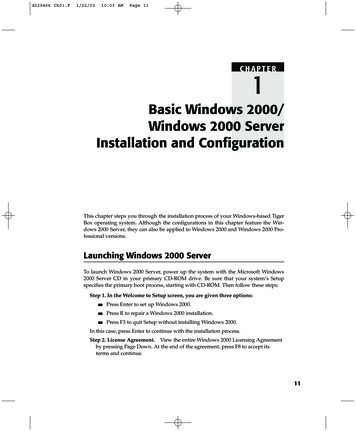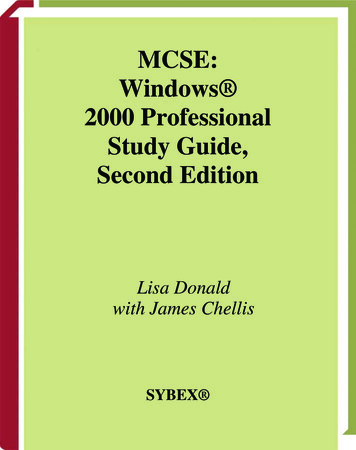
Transcription
MCSE:Windows 2000 ProfessionalStudy Guide,Second EditionLisa Donaldwith James ChellisSYBEX
MCSE:Windows 2000 ProfessionalStudy GuideSecond EditionLisa Donaldwith James ChellisSan Francisco Paris Düsseldorf Soest LondonCopyright 2001 SYBEX, Inc., Alameda, CAwww.sybex.com
Associate Publisher: Neil EddeContracts and Licensing Manager: Kristine O’CallaghanAcquisitions and Developmental Editor: Jeff KellumEditors: Carol Henry, Suzanne Goraj, Linda Orlando, Marilyn SmithProduction Editor: Shannon MurphyTechnical Editors: Michelle A. Roudebush, Donald FullerBook Designer: Bill GibsonGraphic Illustrator: Tony JonickElectronic Publishing Specialist: Nila NicholsProofreaders: Judith Hibbard, Emily Hsuan, Nelson Kim, Laurie O’Connell, Yariv Rabinovitch, Nancy RiddioughIndexer: Ted LauxCD Coordinator: Christine HarrisCD Technician: Kevin LyCover Designer: Archer DesignCover Photographer: Natural SelectionCopyright 2001 SYBEX Inc., 1151 Marina Village Parkway, Alameda, CA 94501. World rights reserved. No part of thispublication may be stored in a retrieval system, transmitted, or reproduced in any way, including but not limited to photocopy, photograph, magnetic, or other record, without the prior agreement and written permission of the publisher.First edition copyright 2000 SYBEX Inc.Library of Congress Card Number: 2001088246ISBN: 0-7821-2946-3SYBEX and the SYBEX logo are either registered trademarks or trademarks of SYBEX Inc. in the United States and/or othercountries.Screen reproductions produced with FullShot 99. FullShot 99 1991-1999 Inbit Incorporated. All rights reserved.FullShot is a trademark of Inbit Incorporated.Microsoft Internet Explorer 1996 Microsoft Corporation. All rights reserved. Microsoft, the Microsoft InternetExplorer logo, Windows, Windows NT, and the Windows logo are either registered trademarks or trademarks of MicrosoftCorporation in the United States and/or other countries.Screen shot(s) reprinted by permission from Microsoft Corporation.SYBEX is an independent entity from Microsoft Corporation, and not affiliated with Microsoft Corporation in any manner.This publication may be used in assisting students to prepare for a Microsoft Certified Professional Exam. Neither MicrosoftCorporation, its designated review company, nor SYBEX warrants that use of this publication will ensure passing the relevant exam. Microsoft is either a registered trademark or trademark of Microsoft Corporation in the United States and/orother countries.TRADEMARKS: SYBEX has attempted throughout this book to distinguish proprietary trademarks from descriptive termsby following the capitalization style used by the manufacturer.The author and publisher have made their best efforts to prepare this book, and the content is based upon final release software whenever possible. Portions of the manuscript may be based upon pre-release versions supplied by software manufacturer(s). The author and the publisher make no representation or warranties of any kind with regard to the completenessor accuracy of the contents herein and accept no liability of any kind including but not limited to performance, merchantability, fitness for any particular purpose, or any losses or damages of any kind caused or alleged to be caused directly orindirectly from this book.Manufactured in the United States of America10 9 8 7 6 5 4 3 2 1Copyright 2001 SYBEX, Inc., Alameda, CAwww.sybex.com
To Our Valued Readers:When Sybex published the first editions of the four core Windows 2000 MCSE Study Guides,Windows 2000 had been out for only six months, and the MCSE exams had just been released. Inwriting the Study Guides, the authors brought to the table their experience with Windows 2000 aswell as insights gained from years of classroom teaching. With the official Microsoft exam objectivesas their guides, the authors set out to write comprehensive, yet ultimately clear, concise, and practicalcourseware. And we believe they succeeded.Over the past year, however, our authors have learned many new things about how Windows 2000works and have received significant and useful feedback about how Microsoft is testing individuals onthe vast array of topics encompassed by the four core exams. We at Sybex have also received atremendous amount of invaluable feedback both praise and criticism regarding the four coreWindows 2000 Study Guides. The second edition that you hold in your hand is the product of thefeedback that readers such as yourself have provided to us.So what “new and improved” material will you find in this new edition? We have confidence in thecore instructional material in the books, so the authors have made only minor modifications to thiscontent. They have, however, made the chapter review questions and bonus exam questions morechallenging, to better reflect the type of questions you’ll encounter on the actual exams. We’ve alsoadded Real World Scenarios throughout the book. This new feature allowed the authors to add criticalcontext and perspective on Windows 2000 technologies that wasn’t available when Microsoft firstreleased the products. Finally, we’ve added Exam Essentials to the end of each chapter. These reemphasize those subject areas that are most important for success on the exams.We believe you’ll find this Study Guide to be an indispensable part of your exam prep program. Asalways, your feedback is important to us. Please send comments, questions, or suggestions tosupport@sybex.com. At Sybex we’re continually striving to meet and exceed the needs of individualspreparing for IT certification exams. Readers like you are critical to these efforts.Good luck in pursuit of your MCSE!Neil EddeAssociate Publisher—CertificationSybex, Inc.SYBEX Inc. 1151 Marina Village Parkway, Alameda, CA 94501Tel: 510/523-8233Fax: 510/523-2373 HTTP://www.sybex.comCopyright 2001 SYBEX, Inc., Alameda, CAwww.sybex.com
Software License Agreement: Terms and ConditionsThe media and/or any online materials accompanying thisbook that are available now or in the future contain programs and/or text files (the "Software") to be used in connection with the book. SYBEX hereby grants to you a license touse the Software, subject to the terms that follow. Your purchase, acceptance, or use of the Software will constitute youracceptance of such terms.The Software compilation is the property of SYBEX unlessotherwise indicated and is protected by copyright to SYBEXor other copyright owner(s) as indicated in the media files(the "Owner(s)"). You are hereby granted a single-userlicense to use the Software for your personal, noncommercialuse only. You may not reproduce, sell, distribute, publish,circulate, or commercially exploit the Software, or any portion thereof, without the written consent of SYBEX and thespecific copyright owner(s) of any component softwareincluded on this media.In the event that the Software or components include specificlicense requirements or end-user agreements, statements ofcondition, disclaimers, limitations or warranties ("End-UserLicense"), those End-User Licenses supersede the terms andconditions herein as to that particular Software component.Your purchase, acceptance, or use of the Software will constitute your acceptance of such End-User Licenses.By purchase, use or acceptance of the Software you furtheragree to comply with all export laws and regulations of theUnited States as such laws and regulations may exist fromtime to time.Software SupportComponents of the supplemental Software and any offersassociated with them may be supported by the specificOwner(s) of that material but they are not supported bySYBEX. Information regarding any available support may beobtained from the Owner(s) using the information provided inthe appropriate read.me files or listed elsewhere on the media.Should the manufacturer(s) or other Owner(s) cease to offersupport or decline to honor any offer, SYBEX bears noresponsibility. This notice concerning support for the Software is provided for your information only. SYBEX is not theagent or principal of the Owner(s), and SYBEX is in no wayresponsible for providing any support for the Software, nor isit liable or responsible for any support provided, or not provided, by the Owner(s).WarrantySYBEX warrants the enclosed media to be free of physicaldefects for a period of ninety (90) days after purchase. TheSoftware is not available from SYBEX in any other form ormedia than that enclosed herein or posted to www.sybex.com. If you discover a defect in the media during this warranty period, you may obtain a replacement of identicalformat at no charge by sending the defective media, postageprepaid, with proof of purchase to:SYBEX Inc.Customer Service Department1151 Marina Village ParkwayAlameda, CA 94501(510) 523-8233Fax: (510) 523-2373e-mail: info@sybex.comWEB: HTTP://WWW.SYBEX.COMAfter the 90-day period, you can obtain replacement mediaof identical format by sending us the defective disk, proof ofpurchase, and a check or money order for 10, payable toSYBEX.DisclaimerSYBEX makes no warranty or representation, eitherexpressed or implied, with respect to the Software or its contents, quality, performance, merchantability, or fitness for aparticular purpose. In no event will SYBEX, its distributors,or dealers be liable to you or any other party for direct, indirect, special, incidental, consequential, or other damagesarising out of the use of or inability to use the Software or itscontents even if advised of the possibility of such damage. Inthe event that the Software includes an online update feature,SYBEX further disclaims any obligation to provide this feature for any specific duration other than the initial posting.The exclusion of implied warranties is not permitted by somestates. Therefore, the above exclusion may not apply to you.This warranty provides you with specific legal rights; theremay be other rights that you may have that vary from state tostate. The pricing of the book with the Software by SYBEXreflects the allocation of risk and limitations on liability contained in this agreement of Terms and Conditions.Shareware DistributionThis Software may contain various programs that are distributed as shareware. Copyright laws apply to both sharewareand ordinary commercial software, and the copyrightOwner(s) retains all rights. If you try a shareware programand continue using it, you are expected to register it. Individual programs differ on details of trial periods, registration,and payment. Please observe the requirements stated inappropriate files.Copy ProtectionThe Software in whole or in part may or may not be copyprotected or encrypted. However, in all cases, reselling orredistributing these files without authorization is expresslyforbidden except as specifically provided for by the Owner(s)therein.Copyright 2001 SYBEX, Inc., Alameda, CAwww.sybex.com
For Kevin. You are the best!Copyright 2001 SYBEX, Inc., Alameda, CAwww.sybex.com
AcknowledgmentsThis book is the result of a great team. First, I’d like to thank CarolHenry (on the second edition) and Marilyn Smith (on the first edition), whoboth did a tremendous job of translating my writing into a form that is veryreadable. Marilyn and Carol put in countless hours and worked through mymany revisions as the book evolved. In addition, they were both super peopleto work with.I’d also like to thank the team that made this book possible. Thanks toJames Chellis for allowing me to work on the MCSE series. James is a visionary and is my business idol. Neil Edde, the Associate Publisher for this series,has nurtured the MCSE since the early days. Jeff Kellum, the Acquisitionsand Developmental Editor, is always fun to work with (even though he canbe a slave driver at times). Shannon Murphy, the Production Editor, somehow managed to keep this project on track, which was not always an easy task.Michelle Roudebush and Donald Fuller worked as the Technical Editors.They did a great job of keeping me honest and minimizing any errors withinthe book. Any errors missed by the editor and technical editors were caughtby the book’s proofreaders: Judith Hibbard, Emily Hsuan, Nelson Kim,Laurie O’Connell, Yariv Rabinovitch, and Nancy Riddiough. Tony Jonickdeveloped the artwork from my drawings. Nila Nichols worked as the Electronic Publishing Specialist. Christine Harris and Kevin Ly managed and created content for the accompanying CD. Matthew Sheltz worked very hardon the CD test engine and is also very appreciated. Without the great workof the team, this book would not have been possible.On the local front, I’d like to thank Martina Fiserova, who keeps my lifesane. Without her, I’d never get anything done. I’d also like to thank my family for always supporting me.Copyright 2001 SYBEX, Inc., Alameda, CAwww.sybex.com
IntroductionMicrosoft’s Microsoft Certified Systems Engineer (MCSE) track forWindows 2000 is the premier certification for computer industry professionals. Covering the core technologies around which Microsoft’s future will bebuilt, the MCSE Windows 2000 program is a powerful credential for careeradvancement.This book has been developed to give you the critical skills and knowledgeyou need to prepare for one of the core requirements of the new MCSE certification program: Installing, Configuring, and Administering MicrosoftWindows 2000 Professional (Exam 70-210).The Microsoft Certified Professional ProgramSince the inception of its certification program, Microsoft has certified overone million people. As the computer network industry grows in both size andcomplexity, these numbers are sure to grow—and the need for proven abilitywill also increase. Companies rely on certifications to verify the skills of prospective employees and contractors.Microsoft has developed its Microsoft Certified Professional (MCP) program to give you credentials that verify your ability to work with Microsoftproducts effectively and professionally. Obtaining your MCP certificationrequires that you pass any one Microsoft certification exam. Several levels ofcertification are available based on specific suites of exams. Depending onyour areas of interest or experience, you can obtain any of the followingMCP credentials:Microsoft Certified System Engineer (MCSE) This certification track isdesigned for network and systems administrators, network and systemsanalysts, and technical consultants who work with Microsoft Windows 2000 client and server software. You must take and pass sevenexams to obtain your MCSE.Since this book covers one of the Core MCSE exams, we will discuss theMCSE certification in detail in this Introduction.Copyright 2001 SYBEX, Inc., Alameda, CAwww.sybex.com
xxviiiIntroductionMicrosoft Certified Solution Developer (MCSD) This track is designedfor software engineers and developers and technical consultants who primarily use Microsoft development tools. Currently, you can take examson Visual Basic, Visual C , and Visual FoxPro. However, withMicrosoft’s pending release of Visual Studio 7, you can expect therequirements for this track to change by the end of 2001. You must takeand pass four exams to obtain your MCSD.Microsoft Certified Database Administrator (MCDBA) This track isdesigned for database administrators, developers, and analysts who workwith Microsoft SQL Server. As of this printing, you can take exams oneither SQL Server 7 or SQL Server 2000, but Microsoft is expected toannounce the retirement of SQL Server 7. You must take and pass fourexams to achieve MCDBA status.Microsoft Certified Trainer (MCT) The MCT track is designed for anyIT professional who develops and teaches Microsoft-approved courses.To become an MCT, you must first obtain your MCSE, MCSD, orMCDBA; then you must take a class at one of the Certified TechnicalTraining Centers. You will also be required to prove your instructionalability. You can do this in various ways: by taking a skills-building ortrain-the-trainer class; by achieving certification as a trainer from any ofa number vendors; or by becoming a Certified Technical Trainer throughthe Chauncey Group (www.chauncey.com/ctt.html). Last of all, youwill need to complete an MCT application.As of March 1, 2001, Microsoft no longer offers MCSE NT 4 required exams.Those who are certified in NT 4 have until December 31, 2001, to upgrade theircredentials to Windows 2000. Also, Microsoft has retired three other certification tracks: MCP Internet, MCSE Internet, and MCP Site Builder. The topicsand concepts that are tested in these certifications have been incorporatedinto the MCSE and MCSD exams.Copyright 2001 SYBEX, Inc., Alameda, CAwww.sybex.com
IntroductionxxixWindows 2000Over the next few years, companies around the world will deploy millionsof copies of Windows 2000 as the central operating system for their missioncritical networks. This will generate an enormous need for qualified consultants and personnel who can design, deploy, and support Windows 2000networks.Because Windows 2000 is such a vast product, its administrators must havea wealth of professional skills. As an example of Windows 2000’s complexity, consider it has more than 35 million lines of code as compared with Windows NT 4’s 12 million! Much of this code is needed to support the widerange of functionality that Windows 2000 offers.The Windows 2000 line comprises several versions:Windows 2000 Professional This is the client edition of Windows 2000,which is comparable to Windows NT Workstation 4 but also includes thebest features of Windows 98, as well as many new features.Windows 2000 Server/Windows 2000 Advanced Server A server editionof Windows 2000, this version is for small to midsized deployments.Advanced Server supports more memory and processors than Server does.Windows 2000 Datacenter Server This is a server edition of Windows 2000for large, widescale deployments and computer clusters. Datacenter Serversupports the most memory and processors of the three versions.Companies implementing the expansive Windows 2000 operating systemwant to be certain that you are the right person for the job being offered.The MCSE track is designed to help you prove that you are.How Do You Become an MCSE?Attaining MCSE certification has always been a challenge. In the past, students have been able to acquire detailed exam information—even most ofthe exam questions—from online “brain dumps” and third-party “cram”books or software products. For the new MCSE exams, this is simply notthe case.Copyright 2001 SYBEX, Inc., Alameda, CAwww.sybex.com
xxxIntroductionMicrosoft has taken strong steps to protect the security and integrity ofthe new MCSE track. Now, prospective MCSEs must complete a course ofstudy that develops detailed knowledge about a wide range of topics. Itsupplies them with the true skills needed, derived from working withWindows 2000 and related software products.The new MCSE program is heavily weighted toward hands-on skills andexperience. Microsoft has stated that “nearly half of the core requiredexams’ content demands that the candidate have troubleshooting skillsacquired through hands-on experience and working knowledge.”Fortunately, if you are willing to dedicate the time and effort to learn Windows 2000, you can prepare yourself well for the exams by using the propertools. By working through this book, you can successfully meet the examrequirements.This book is part of a complete series of Sybex MCSE Study Guides, published by Sybex Inc., that together cover the core Windows 2000 requirements as well as the new Design exams needed to complete your MCSEtrack. Study Guide titles include the following: MCSE: Windows 2000 Professional Study Guide, Second Edition, byLisa Donald with James Chellis (Sybex, 2001) MCSE: Windows 2000 Server Study Guide, Second Edition, by LisaDonald with James Chellis (Sybex, 2001) MCSE: Windows 2000 Network Infrastructure Administration StudyGuide, Second Edition, by Paul Robichaux with James Chellis(Sybex, 2001) MCSE: Windows 2000 Directory Services Administration StudyGuide, Second Edition, by Anil Desai with James Chellis (Sybex, 2001) MCSE: Windows 2000 Network Security Design Study Guide, byGary Govanus and Robert King (Sybex, 2000) MCSE: Windows 2000 Network Infrastructure Design Study Guide,by Bill Heldman (Sybex, 2000) MCSE: Windows 2000 Directory Services Design Study Guide, byRobert King and Gary Govanus (Sybex, 2000)Copyright 2001 SYBEX, Inc., Alameda, CAwww.sybex.com
IntroductionxxxiExam RequirementsCandidates for MCSE certification in Windows 2000 must pass sevenexams, including four core operating system exams, one design exam, andtwo electives, as described in the sections that follow.DesignRequirementCoreRequirementsDesigning aWindows 2000DirectoryServicesInfrastructure(70-219)Windows 2000Professional(70-210)Windows 2000Server(70-215)Plus one ofthe followingWindows dows ngSecurity for aWindows 2000Network(70-220)Designing aWindows 2000NetworkInfrastructure(70-221)ElectivesAny of theDesign examsnot taken forthe DesignrequirementPlus two ofthe followingAny currentElective exam.Topics includeExchange Server,SQL Server, andISA Server.Designing WebSolutions withWindows 2000ServerTechnologies(70-226)For a more detailed description of the Microsoft certification programs,including a list of current and future MCSE electives, check Microsoft’s Training and Certification Web site at www.microsoft.com/trainingandservices.Copyright 2001 SYBEX, Inc., Alameda, CAwww.sybex.com
xxxiiIntroductionThe Installing, Configuring, and Administering MicrosoftWindows 2000 Professional ExamThe Windows 2000 Professional exam covers concepts and skills related toinstalling, configuring, and managing Windows 2000 Professional computers. It emphasizes the following elements of Windows 2000 Professionalsupport: Installing Windows 2000 Professional Implementing and administering resources Implementing, managing, and troubleshooting resources Monitoring and optimizing system performance and reliability Configuring and troubleshooting the Desktop environment Implementing, managing, and troubleshooting network protocols andservices Implementing, monitoring, and troubleshooting securityThis exam is quite specific regarding Windows 2000 Professional requirements and operational settings, and it can be particular about how administrative tasks are performed within the operating system. It also focuses onfundamental concepts of Windows 2000 Professional’s operation. Carefulstudy of this book, along with hands-on experience, will help you to preparefor this exam.Microsoft provides exam objectives to give you a very general overview ofpossible areas of coverage on the Microsoft exams. For your convenience,this Study Guide includes objective listings positioned within the text atpoints where specific Microsoft exam objectives are discussed. Keep in mind,however, that exam objectives are subject to change at any time without priornotice and at Microsoft’s sole discretion. Please visit Microsoft’s Training andCertification Web site (www.microsoft.com/trainingandservices) for themost current listing of exam objectives.Copyright 2001 SYBEX, Inc., Alameda, CAwww.sybex.com
IntroductionxxxiiiTypes of Exam QuestionsIn an effort to both refine the testing process and protect the quality of itscertifications, Microsoft has focused its Windows 2000 exams on real experience and hands-on proficiency. There is a higher emphasis on your pastworking environments and responsibilities, and less emphasis on how wellyou can memorize. In fact, Microsoft says an MCSE candidate should haveat least one year of hands-on experience.Microsoft will accomplish its goal of protecting the exams’ integrity by regularly adding and removing exam questions, limiting the number of questionsthat any individual sees in a beta exam, limiting the number of questionsdelivered to an individual by using adaptive testing, and adding new examelements.Exam questions may be in a variety of formats: Depending on whichexam you take, you’ll see multiple-choice questions, as well as select-andplace and prioritize-a-list questions. Simulations and case study–based formats are included, as well. You may also find yourself taking what’s calledan adaptive format exam. Let’s take a look at the types of exam questionsand examine the adaptive testing technique, so that you’ll be prepared for allof the possibilities.With the release of Windows 2000, Microsoft has stopped providing a detailedscore breakdown. This is mostly because of the various and complex questionformats. Previously, each question focused on one objective. The Windows 2000exams, however, contain questions that may be tied to one or more objectivesfrom one or more objective sets. Therefore, grading by objective is almostimpossible.For more information on the various exam question types, go p?PageID mcp&PageCall tesinn&SubSite examinfo.Copyright 2001 SYBEX, Inc., Alameda, CAwww.sybex.com
xxxivIntroductionMULTIPLE-CHOICE QUESTIONSMultiple-choice questions come in two main forms. One is a straightforwardquestion followed by several possible answers, of which one or more is correct. The other type of multiple-choice question is more complex andbased on a specific scenario. The scenario may focus on a number of areasor objectives.SELECT-AND-PLACE QUESTIONSSelect-and-place exam questions involve graphical elements that you mustmanipulate in order to successfully answer the question. For example, youmight see a diagram of a computer network, as shown in the followinggraphic taken from the select-and-place demo downloaded from Microsoft’sWeb site.A typical diagram will show computers and other components next toboxes that contain the text “Place here.” The labels for the boxes representvarious computer roles on a network, such as a print server and a file server.Based on information given for each computer, you are asked to select eachlabel and place it in the correct box. You need to place all of the labels correctly. No credit is given for the question if you correctly label only some ofthe boxes.Copyright 2001 SYBEX, Inc., Alameda, CAwww.sybex.com
IntroductionxxxvIn another select-and-place problem you might be asked to put a series ofsteps in order, by dragging item from boxes on the left to boxes on the right,and placing them in the correct order. One other type requires that you dragan item from the left and place it under an item in a column on the right.SIMULATIONSSimulations are the kinds of questions that most closely represent actual situations and test the skills you use while working with Microsoft softwareinterfaces. These exam questions include a mock interface on which you areasked to perform certain actions according to a given scenario. The simulated interfaces look nearly identical to what you see in the actual product,as shown in this example:Because of the number of possible errors that can be made on simulations,be sure to consider the following recommendations from Microsoft: Do not change any simulation settings that don’t pertain to the solution directly.Copyright 2001 SYBEX, Inc., Alameda, CAwww.sybex.com
xxxviIntroduction When related information has not been provided, assume that thedefault settings are used. Make sure that your entries are spelled correctly. Close all the simulation application windows after completing the setof tasks in the simulation.The best way to prepare for simulation questions is to spend time workingwith the graphical interface of the product on which you will be tested.We recommend that you study with the WinSim 2000 product, which isincluded on the CD that accompanies this study guide. By completing theexercises in this study guide and working with the WinSim 2000 software, youwill greatly improve your level of preparation for simulation questions.CASE STUDY–BASED QUESTIONSCase study–based questions first appeared in the MCSD program. Thesequestions present a scenario with a range of requirements. Based on theinformation provided, you answer a series of multiple-choice and select-andplace questions. The interface for case study–based questions has a numberof tabs, each of which contains information about the scenario.At present, this type of question appears only in most of the Design exams.ADAPTIVE EXAM FORMATMicrosoft presents many of its exams in an adaptive format. This format isradically different from the conventional format previously used forMicrosoft certification exams. Conventional tests are static, containing afixed number of questions. Adaptive tests change depending on youranswers to the questions presented.The number of questions presented in your adaptive test will depend onhow long it takes the exam to ascertain your level of ability (according to thestatistical measurements on which exam questions are ranked). To determine a test-taker’s level of ability, the exam presents questions in an increasing or decreasing order of difficulty.Copyright 2001 SYBEX, Inc., Alameda, CAwww.sybex.com
IntroductionxxxviiUnlike the earlier test format, the adaptive test does not allow you to go backto see a question again. The exam only goes forward. Once you enter youranswer, that’s it—you cannot change it. Be very careful before entering youranswers. There is no time limit for each individual question (only for the exam asa whole). Your exam may be shortened by correct answers (and lengthened byincorrect answers), so there is no advantage to rushing through questions.Microsoft will regularly add and remove questions from the exams. This iscalled item seeding. It is part of the effort to make it more difficult for individuals to merely memorize exam questions that were passed along by previoustest-takers.Exam Question DevelopmentMicrosoft follows an exam-development process consisting of
When Sybex published the first editions of the four core Windows 2000 MCSE Study Guides, Windows 2000 had been out for only six months, and the MCSE exams had just been released. In writing the Study Guides, the authors brought to the table their experience with Windows 2000 as well as insights gained from years of classroom teaching.
